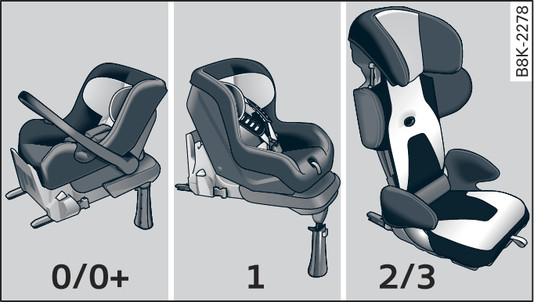|
|
Only use child restraint systems that are officially approved and suitable for the child.
Child restraint systems are regulated by European standards ECE R 44 or ECE-R 1291). Both standards apply in parallel. An orange label is normally attached to child seats which have been tested in accordance with these standards. Information on weight categories, ISOFIX size class and the approval category of the child seat can be found on this label.
Weight categories for child seats
- Child seats: categories 0 and 0+: Rearward-facing carry cots are most appropriate for these categories (up to 13 kg). Our recommendation: Audi carry cot with optional ISOFIX base.
- Child seats: category 1: In this category (9 to 18 kg), rearward or forward-facing child seats with an integrated seat belt system are most appropriate. Rearward-facing child seats should be used for as long as safely possible. Our recommendation: Audi child seat with ISOFIX base.
- Child seats: categories 2 and 3: Child seats with backrests used in conjunction with seat belts are most appropriate for these categories (15 to 36 kg). Our recommendation: Audi child seat "youngster plus".
Approval categories for child seats
Child seats can have the approval categories universal, semi-universal, vehicle-specific (all according to the ECE-R 44 standard) or i-Size (according to the ECE-R 129 standard).
- Universal: Child seats approved for the universal category are suitable for installation in any vehicle. A model list is not required. Universal category child seats for ISOFIX anchorages must be secured additionally by a top tether strap.
- Semi-universal: Safety appliances requiring additional tests are required for securing a child seat with semi-universal approval. Child seats with semi-universal approval have a model list which must include your vehicle.
- Vehicle-specific: Vehicle-specific approval requires that the child seat undergo a separate dynamic test for each vehicle model. Child seats with a vehicle-specific approval also have a model list.
- i-Size: Child seats with i-Size approval must comply with the installation and safety requirements specified in the ECE-R 129 standard. Your child seat manufacturer can inform you which child seats with i-Size approval are appropriate for your vehicle.
- Rearward-facing child seats: Never install a rearward-facing child seat on the front passenger s seat unless the front passenger s airbag has been deactivated – this can result in potentially fatal injuries to the child. If you have no alternative but to let a child travel on the front passenger s seat, the front passenger s airbag must be deactivated* beforehand link►.
- Forward-facing child seats: The back of the child seat should be flush with the backrest of the vehicle seat. If the rear head restraint obstructs you when installing the child seat, adjust or remove it completely link►. Install the head restraint again immediately after removing the child seat. Adjust the head restraint to the correct height for the passenger. Travelling with the head restraints removed or incorrectly adjusted increases the risk of severe injuries.
- Categories 2 and 3: The shoulder section of the belt must be fitted across the centre of the child s collar bone close to the torso. It must never run against or across the neck. The lap belt must be worn tightly across the hips, and not over the stomach or abdomen. Pull the belt tight if necessary to take up any slack.
- Wait for as long as possible before changing up to the next child seat group.
Note
We recommend child seats from the range of Audi Genuine Accessories: www.audi.com/childseats.
